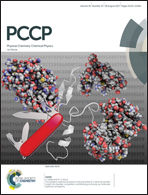Interpenetration of CH3NH3PbI3 and TiO2 improves perovskite solar cells while TiO2 expansion leads to degradation†
Abstract
Perovskite solar cells have drawn much attention and achieved efficiencies over 22%, but relatively little is known about the long-term stability under photovoltaic operation. So far, stability studies have reported about the importance of degradation of each layer, but little to no consideration has been given to the whole device architecture. We investigated the stability of perovskite solar cells in order to fundamentally understand the mechanism behind efficiency improvement/degradation during device operation. We found that during operation the interfaces of the perovskite and the electron-transport layer (ETL), meso-porous TiO2, further intermix with each other, which leads to improved power conversion efficiency (PCE) during the initial operation of these solar cells. The operation-induced structural changes are examined directly by X-ray photoelectron spectroscopy (XPS) with in situ low-energy Ar+ sputtering and time-of-flight secondary ion mass spectrometry (ToF-SIMS) with C60 sputtering. In addition, this study describes that the primary cause of irreversible degradation during operation is due to the expansion of TiO2 and ion migration throughout the perovskite solar cell.



 Please wait while we load your content...
Please wait while we load your content...